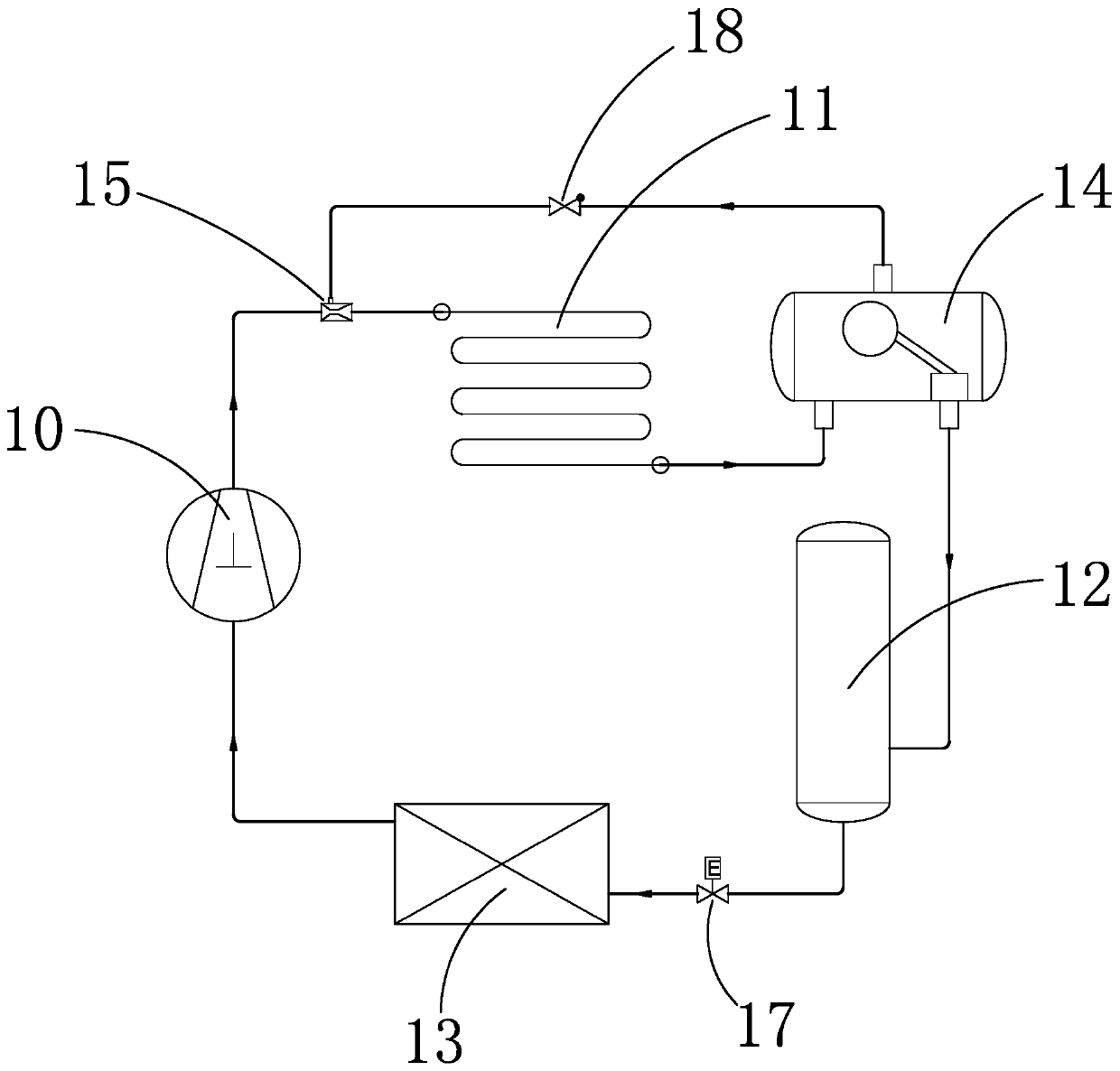Carbon dioxide refrigerating system and refrigerating method thereof
A carbon dioxide, refrigeration system technology, applied in refrigerators, refrigeration components, refrigeration and liquefaction, etc., can solve the problems of low efficiency, high cost, complex system structure and other problems of refrigeration systems, and achieve improved refrigeration efficiency, high natural content, and improved condensation. amount of effect
- Summary
- Abstract
- Description
- Claims
- Application Information
AI Technical Summary
Problems solved by technology
Method used
Image
Examples
Embodiment 1
[0070] see figure 1 As shown, a carbon dioxide refrigeration system provided in this embodiment includes a compressor 10, a condenser 11, a liquid receiver 12 and an evaporator 13 connected in sequence, and the carbon dioxide gas discharged from the compressor 10 enters the condenser 11 and is Condensed into a liquid and stored in the liquid storage device 12, the carbon dioxide liquid is evaporated and refrigerated in the evaporator 13 and then flows back to the compressor 10 for repeated use to realize the cycle of carbon dioxide; a suction assembly 15 is arranged between the compressor 10 and the condenser 11 , the suction assembly 15 communicates with the reservoir 12 ( Figure 19 shown) or communicate with the gas-liquid separator 14 ( figure 1 shown), the gas-liquid separator 14 is arranged between the condenser 11 and the liquid receiver 12, and the carbon dioxide gas in the liquid receiver 12 or the gas-liquid separator 14 can be drawn back to the compressor 10 and th...
Embodiment 2
[0102] The difference between this embodiment and Embodiment 1 is that the condenser in this embodiment is clearly a flash condenser, and the system flow is the same as that in Embodiment 1. In the refrigeration system using carbon dioxide as the cooling medium, due to the low critical point of carbon dioxide, it is currently impossible to solve the problem of liquefying gaseous carbon dioxide when the external temperature is too high. The scope of refrigeration cannot be widely used. The applicant of the present invention has been studying the refrigeration system using carbon dioxide as the refrigeration medium. The first generation developed the ground source condensation technology, which has been widely used. After years of research, a new flash evaporation Condensation technology solves the technical problem of condensing carbon dioxide medium for refrigeration, so that the condensation pressure of carbon dioxide is not higher than its critical pressure and is completely ...
Embodiment 3
[0138] The content of this embodiment includes the technical solutions of Embodiment 1 and Embodiment 2. On the basis of Embodiment 1 and Embodiment 2, in order to realize the use of carbon dioxide medium for refrigeration, it can also be switched to heating mode, see Figure 16 and Figure 17 As shown, the carbon dioxide refrigeration and heating system includes a first four-way reversing valve 35, a second four-way reversing valve 36, and a third four-way reversing valve 37. The four outlets of the first four-way reversing valve 35 respectively pass through The gas pipeline is connected to the inlet of the condenser 11, the inlet of the compressor 10, the outlet of the compressor 10, and the outlet of the evaporator 13; two of the outlets of the second four-way reversing valve 36 are respectively connected to the outlet of the condenser 11, the gas-liquid Separator 14 inlet (or reservoir 12 inlet), other two outlets are respectively connected with two outlets of the third f...
PUM
 Login to View More
Login to View More Abstract
Description
Claims
Application Information
 Login to View More
Login to View More - Generate Ideas
- Intellectual Property
- Life Sciences
- Materials
- Tech Scout
- Unparalleled Data Quality
- Higher Quality Content
- 60% Fewer Hallucinations
Browse by: Latest US Patents, China's latest patents, Technical Efficacy Thesaurus, Application Domain, Technology Topic, Popular Technical Reports.
© 2025 PatSnap. All rights reserved.Legal|Privacy policy|Modern Slavery Act Transparency Statement|Sitemap|About US| Contact US: help@patsnap.com



